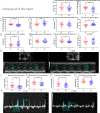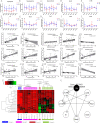Harm of circadian misalignment to the hearts of the adolescent wistar rats
- PMID: 35933342
- PMCID: PMC9356460
- DOI: 10.1186/s12967-022-03546-w
Harm of circadian misalignment to the hearts of the adolescent wistar rats
Abstract
Purpose: The purpose of this study was to observe the harm of circadian misalignment (CM), caused by an inverted photoperiod (IP), on the hearts of the adolescent Wistar rats, and to explore the mechanisms leading to harm.
Methods: An IP was used to create a CM model. A total of 174 Wistar rats were randomly divided into circadian alignment (CA) and CM groups (87 rats per group). The different activity rhythms of the two groups of rats were adjusted through different light/dark cycles for 90 days. We recorded the rhythmic activity trajectory and sleep time of the rats. After 90 days of modeling, we performed various analyses (i.e., blood pressure, weight, cardiac ultrasound tests, serological tests, cardiac tissue immunofluorescence, immunohistochemistry, transmission electron microscopy on myocardial mitochondria, western blotting, and quantitative polymerase chain reactions).
Results: (1) The IP protocol caused CM in rats. (2) CM rats showed significantly higher blood pressure during the day (resting phase). They also showed significantly higher serum levels of angiotensin II and epinephrine during the day compared to the CA rats. (3) CM caused up-regulation of gene expression of adrenergic receptors α1 (α1-AR) and β1 (β1-AR) and down-regulation of the glucocorticoid receptor (Gr) gene expression in rat hearts. It also caused downregulation of Bmal1 expression. In addition, the changes in Bmal1 and Per2 correlated with the changes in β1-AR and α1-AR. (4) CM had adverse effects on multiple molecular proteins of the heart. (5) CM increased the collagen fibers in the rat heart and increased the destruction of mitochondria. (6) Eventually, CM caused a decrease in the pumping function of the heart and decreased the coronary blood flow rate.
Conclusions: (1) CM significantly affected the cardiac structure and function in the adolescent rats through a variety of mechanisms. (2) CM can regulate the expression of myocardial clock genes, and it is likely to have an impact on the heart through this pathway.
Keywords: Adolescent rats; Blood pressure; Circadian misalignment; Clock gene; Heart.
© 2022. The Author(s).
Conflict of interest statement
None.
Figures







Similar articles
-
Effect of angiotensin II on rhythmic per2 expression in the suprachiasmatic nucleus and heart and daily rhythm of activity in Wistar rats.Regul Pept. 2013 Sep 10;186:49-56. doi: 10.1016/j.regpep.2013.06.016. Epub 2013 Jul 12. Regul Pept. 2013. PMID: 23850797
-
Effect of phase delay lighting rotation schedule on daily expression of per2, bmal1, rev-erbα, pparα, and pdk4 genes in the heart and liver of Wistar rats.Mol Cell Biochem. 2011 Feb;348(1-2):53-60. doi: 10.1007/s11010-010-0636-x. Epub 2010 Nov 14. Mol Cell Biochem. 2011. PMID: 21076970
-
Altered circadian rhythm of cardiac β3-adrenoceptor activity following myocardial infarction in the rat.Basic Res Cardiol. 2011 Jan;106(1):37-50. doi: 10.1007/s00395-010-0110-7. Epub 2010 Jul 27. Basic Res Cardiol. 2011. PMID: 20661603
-
Altered diurnal variation and localization of clock proteins in the remnant kidney of 5/6 nephrectomy rats.Nephrology (Carlton). 2013 Aug;18(8):555-62. doi: 10.1111/nep.12111. Nephrology (Carlton). 2013. PMID: 23738784
-
[The roles of clock genes in obesity].Nihon Rinsho. 2013 Feb;71(2):244-8. Nihon Rinsho. 2013. PMID: 23631200 Review. Japanese.
Cited by
-
Chronic Phase Shifts Are Associated With Higher Systolic Blood Pressure and Impaired Glucose Tolerance Independently of Estrogen Deficiency in Female Spontaneously Hypertensive Rats.J Biol Rhythms. 2025 Aug;40(4):384-399. doi: 10.1177/07487304251347464. Epub 2025 Jun 19. J Biol Rhythms. 2025. PMID: 40537446 Free PMC article.
-
Role of circadian rhythms in heart failure: insights from myocardial energy metabolism.J Transl Med. 2025 Jul 10;23(1):770. doi: 10.1186/s12967-025-06828-1. J Transl Med. 2025. PMID: 40640835 Free PMC article. Review.
References
-
- Fagundo-Rivera J, et al. Work, family and nurses perception about their own health: relationship with breast cancer and shift work. Rev Esp Salud Publica. 2021;2:95. - PubMed
Publication types
MeSH terms
Substances
LinkOut - more resources
Full Text Sources
Research Materials

